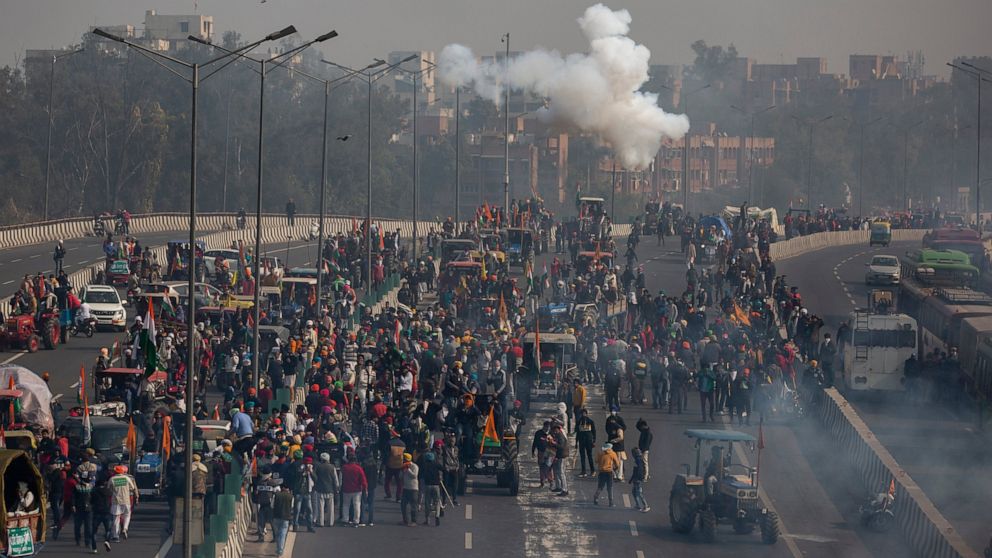Protesting farmers return to camp after storming Indian fort
NEW DELHI — Leaders of a protest movement sought Wednesday to distance themselves from a day of violence when thousands of farmers stormed India’s historic Red Fort, the most dramatic moment in two months of demonstrations that have grown into a major challenge of Prime Minister Narendra Modi’s government.
Farmers demanding the repeal of new agricultural laws briefly took over of the 17th-century fort, and images broadcast live on television shocked the nation. In a particularly bold rebuke to Modi’s Hindu-nationalist government, the protesters hoisted a Sikh religious flag.
At least one protester died, and several demonstrators were injured, as were more than 300 police officers, and there are concerns the violence could undermine the protest movement that has thus far been largely peaceful and is growing in strength.
The farmers — many of them Sikhs from the major agricultural states of Punjab and Haryana — are demanding the repeal of new laws that they fear will favor large corporate agriculture and leave smallholders behind. The government insists the laws will benefit farmers and boost production through private investment, but, in the face of protests, it has offered to suspend them for 18 months. The farmers want nothing less than a full repeal.
On Tuesday, more than 10,000 tractors and thousands more people on foot or horseback moved into the capital, shoving aside barricades and buses blocking their path and at times met by police using tear gas and water cannons.
“The situation is normal now. The protesters have left the streets of the capital,” New Delhi police officer Anto Alphonse said Wednesday morning.
Hundreds of police are now guarding the fort, while the farmers have returned to their camp at the edge of the capital, where they have hunkered down since November, when they last tried to march into New Delhi. Unfazed by the winter cold and frequent rains, they have said they will stay until the farm laws are repealed.
The protesting farmers’ groups are scheduled to meet later Wednesday to discuss the future course of action. Another march is planned for Feb. 1 when the Modi government is scheduled to present the annual budget in Parliament.
As the protests have gathered strength, they have rattled the government like never before since they form the most influential voting bloc in India and are also crucial to its economy. But political analyst Arti Jerath said Tuesday’s violence could dampen their power.
“The Supreme Court has all along said the farmers can continue with the protest without disrupting the life in New Delhi,” she said. “Tuesday’s development has given the government a handle to go to the top court and say see this is precisely what it was fearing that it would turn violent.”
Cracks appeared Wednesday in the protest movement when a former convener of the farmers’ umbrella organization disassociated himself from the group after Tuesday’s violent clashes.
V.M. Singh said he was ready to hold talks with the government on legislation guaranteeing a minimum support price for wheat and rice. He said he is no longer seeking the repeal of the three new laws.
Protest organizer Samyukt Kisan Morcha, or United Farmers’ Front, sought to distance the movement from the violence, accusing two outside groups of sabotage by infiltrating their movement.
“Even if it was a sabotage, we can’t escape responsibility,” said Yogendra Yadav, another protest leader.
Yadav said frustration had built up among the protesting farmers and asked, “how do you control it if the government is not serious about what they have been demanding for two months?”
Several roads were closed again on Wednesday near the police headquarters and Connaught Place, a shopping area close to government offices, following a protest by some retired Delhi police officers demanding prosecution of the protesting farmers who engaged in violence, the Press Trust of India news agency said.
Since returning to power for a second term, Modi’s government has been rocked by several convulsions. The pandemic sent India’s already-teetering economy into recession, social strife has widened and his government has been questioned over its response to the coronavirus pandemic. India last suffered a recession in 1979-80 after an oil shock.
In addition, India has seen a rising tide of Hindu nationalism under Modi that has rankled minority groups. In 2019, the year that witnessed the first major protests against his administration, a diverse coalition of groups rallied against a contentious new citizenship law that they said discriminated against Muslims.
Anger is now also beginning to rise among Sikhs, though the farmers’ protests remain largely driven by economic factors. India is predominantly Hindu while Muslims comprise 14% and Sikhs nearly 2% of its nearly 1.4 billion people.
“The government on the national security front has failed. I think this government seems to be quite blinkered on the kind of security challenges that it is creating for itself by alienating minority communities, Muslims and Sikhs,” said Jerath, the political analyst.
Tuesday’s escalation overshadowed Republic Day celebrations, including the annual military parade that was already scaled back because of the coronavirus pandemic.
Neeraja Choudhury, a political analyst, said the government failed to anticipate what was coming and prepare for it adequately. “If the farmers are agitated overall India, you can’t dismiss the protests as some opposition inciting the farmers.”
Police said the protesting farmers broke away from the approved protest routes and resorted to “violence and vandalism.” Anil Kumar, a police spokesman, said more than 300 police personnel were injured in clashes. Several jumped into a deep dry drain in the fort area to escape the protesters who outnumbered them at several places.
Police said one protester died after his tractor overturned, but farmers said he was shot. Several bloodied protesters could be seen in television footage, it’s not known how many were injured.
Eight buses and 17 private vehicles were damaged, said police, who filed vandalism charges against the protesters.
![]()


